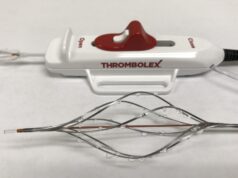
During the 2024 International Venous Conference (April 18-20) in Miami, Florida, Lowell Kabnick, MD (Lake Worth Beach, Florida), gave s presentation on the newest venous devices currently in development.
“We’re going to look into the future a little bit,” Kabnick told the audience. He then went on to explain a number of new venous devices.
The first device in development is the SCureClamp (Amsel Medical), which, through an 18-gauge needle, a clamp is able to occlude blood vessels, arteries, ducts, and veins. The device has been tested in the Dominican Republican and is currently on its second generation.
“We learned that we really needed to make user friendly adjustments to the delivery system of the device. Now, with Gen 2, we’ve gone from a two-handed to one-handed technique,” Kabnick stated. He also spoke about the trauma-application of the SCureClamp TO.
“A lot of our wounds are non-compressible, and that’s important and this could be a potentially life-saving event,” Kabnick continued. The SCureClamp is expected to be available commercially in the near future.
“Let’s shift a little bit to another technique that is mechanical only, non-thermal, and non-chemical. It’s called InVera. This minimally invasive novel medical device is intended to treat venous patients with truncal reflux and is potentially faster than other, similar devices,” Kabnick said.
“The device is a catheter with an abrasive coil,” Kabnick explained. “You insert the catheter under ultrasound guidance into the targeted vein at the lowest point of reflux and up to 2 cm below the saphenofemoral or saphenopopliteal junction. You are going to pull it back causing mechanical disruption to the vein wall…”
As for the clinical results of InVera, “pre-clinical results were good. There were five animals and 10 lateral saphenous veins. [There were] nine complete occlusions and one partial occlusion. There were no adverse effects.”
Moving on from InVera, Kabnick brought a question to the audience, “can we convert a thermal operation into a really non-thermal operation with this device,” he posed. “This is a device called Solutio (MedVasc).”
With the Solutio device, “an RF catheter or laser-fiber will be inserted into a channel of the tumescent delivery device. Tumescent anesthesia is delivered through a built-in needle that is deployed through a separate channel piercing the vein wall and delivering the anesthetizing fluid to the intended target. This device obviates the multiple epidermal needle sticks that cause patient pain/discomfort.”
“If we look at comparisons of tumescent anesthesia delivery technique, obviously this is going to cause less pain,” Kabnick explained. “The point of fact is that in trial, it really did.” The pain scores for patients using the device were low in the study, and the catheter was reported as safe and easy to use.
“They’re going to be doing clinical studies momentarily in the United States as well as in Europe,” Kabnick told the audience.
Kabnick then moved on to discuss what he called a “buzzword.”
“We’ve been hearing about HIFU, high-intensity ultrasound for a number of years,” Kabnick said. “It’s now starting to spread a little bit. It’s in Germany, it’s in Italy, it’s in Czech Republic, and now in the US as a trial.”
“Essentially this is a thermal unit,” Kabnick explained. “Then there’s a cooling membrane, which is disposable. Looking at this slide, you can see that it’s really kind of a process of looking at ultrasound and focalizing the beam to the target area.”
Kabnick then went on to discuss how, with the ever-rising usage of artificial intelligence (AI) across industries, we could streamline the procedure utilizing this device.
Continuing his presentation on high-intensity ultrasound, Kabnick brought up Mark Whiteley’s study that looked at the usage outcomes of high-intensity focused ultrasound (HIFU), HIFU with foam sclerotherapy immediately after procedure, and HIFU with delayed foam sclerotherapy.
The results of that study showed that “HIFU only, at eight weeks 8 of 10 successful closures, or 80%. At one year, 40%. Results of HIFU plus foam sclerotherapy at the same time, a 100% successful closure. At one year, 88% successful closure. HIFU plus late foam sclerotherapy, successful closure was 82%, and then 91% successful closure,” Kabnick said to the audience.
These are only some of the new venous devices that will be coming to the market. It will be interesting to see how these new devices continue to change how surgeons can help patients. The future looks bright!









